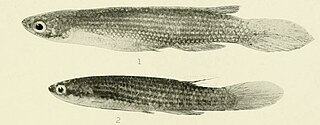
The Rivulidae are a family of killifishes in the order Cyprinodontiformes. They are commonly known as rivulids, South American killifish or New World killifish. The latter names are slightly misleading, however, as they are neither restricted to South America, though most are in fact found there, nor are they the only killifishes from the Americas. Occasionally, they are still referred to as rivulines, a term dating back to when they were considered a subfamily of the Aplocheilidae.

Leptolebias is a ray-finned fish genus of the killifish family Rivulidae. Like many of their relatives, they are rather ambiguously known as "pearlfish".

Austrolebias is a genus of killifish in the family Rivulidae. These annual killifish live in temporary pools, swamps and streams in the Río de la Plata, Patos–Mirim and Mamoré basins in South America.

Hypsolebias is a genus of small fish in the family Rivulidae that are endemic the Caatinga, Cerrado and nearby regions in Brazil. The greatest species richness is in the São Francisco River basin, but there are also species in the Tocantins, Jequitinhonha and Jaguaribe systems, as well as smaller river basins in northeastern Brazil. Like their relatives, Hypsolebias are annual killifish. The short-lived adults inhabit temporary waters like rain pools, laying their eggs in the bottom. As their habitat dries up the adults die, but the eggs survive and hatch when the water returns in the next season.

Anablepsoides is a genus of killifish in the family Rivulidae native to tropical South America and the Lesser Antilles. The majority are from the Amazon and Orinoco basins, as well as freshwater systems in the Guiana Shield, but a few species are from northern Venezuela, northeastern Brazil and the Lesser Antilles. Although largely restricted to lowlands, a few species occur in the lower East Andean foothills. They are mostly found in shallow fresh water swamps, streams, edges of rivers, ponds and pools, but a few may occur in brackish estuaries. They are able to jump over land and breathe air for short periods, allowing them to access isolated waters inhabited by few or no other fish. Several Anablepsoides species have small distributions and some are seriously threatened by habitat loss; the entire known range of A. xinguensis is in the area flooded by the Belo Monte Dam.

Moema is a genus of fish in the family Rivulidae. These annual killifish are mostly restricted to the Amazon basin in Bolivia, Brazil and Peru, but a few inhabit the upper Essequibo basin in Guyana, upper Orinoco basin in Venezuela and upper Paraguay basin in Brazil. They inhabit temporary waters, such as swamps or ponds, in primary forests. Once the water disappears, the adults die, but the eggs that have been laid in the bottom remain, only hatching after 3–10 months when the water returns. They rapidly reach adult size, but generally only live a few months after hatching, although captives can live longer.
Notholebias is a genus of fish in the family Rivulidae. These threatened annual killifish are endemic temporary waters, like ponds, in the Atlantic Forest in Rio de Janeiro state, Brazil.
Xenurolebias is a genus of fish in the family Rivulidae. These annual killifish are endemic to temporary pools in the Atlantic forest near the coast in southeast Bahia and Espírito Santo, Brazil.

Simpsonichthys constanciae is a species of killifish from the family Rivulidae that is endemic to Brazil. It is restricted to temporary freshwater habitats in the São João basin in Rio de Janeiro, while all other species in the genus are from Bahia. It is a small killifish that is up to 6 cm (2.4 in) in total length.

Spectrolebias is a genus of killifish in the family Rivulidae. These annual killifish are endemic to seasonal waters in the Paraguay, Tocantins–Araguaia, Xingu and Mamoré–Grande basins in Bolivia, Brazil and Paraguay. Each species generally has a small distribution and some are seriously threatened by habitat loss; the entire known range of S. reticulatus is in the area flooded by the Belo Monte Dam.
Simpsonichthys fasciatus is a species of killifish in the family Rivulidae. It is found in the Paracatu River drainage of the São Francisco River basin, Brazil.
Simpsonichthys gibberatus is a species of killifish in the family Rivulidae. It is found in the Paracatu River drainage of the São Francisco River basin, Brazil.
Simpsonichthys virgulatus is a species of killifish in the family Rivulidae. It is found in the Paracatu River drainage of the São Francisco River basin, Brazil.
Simpsonichthys delucai is a species of killifish in the family Rivulidae. It is found in Brazil.
Simpsonichthys margaritatus is a species of killifish from the family Rivulidae. It is found in the Verde River floodplains, of the upper Paraná River basin in central Brazil.
Simpsonichthys nielseni is a species of killifish in the family Rivulidae. It is found in the São Francisco River basin, Brazil.
Simpsonichthys ocellatus is a species of killifish from the family Rivulidae. It is found in the Jequitinhonha River basin in Brazil.
Simpsonichthys perpendicularis is a species of killifish in the family Rivulidae. It is found in the Jequitinhonha River basin in Brazil.
Simpsonichthys rufus is a species of killifish from the family Rivulidae. It is found in the São Francisco River basin in Brazil.
Simpsonichthys espinhacensis is a species of killifish from the family Rivulidae. It is found in the upper Jequitinhonha River basin in Minas Gerais, eastern Brazil. The specific name refers to the Espinhaço Mountains where the known range of this species lies.









